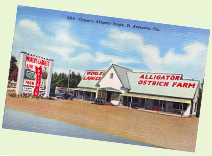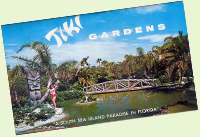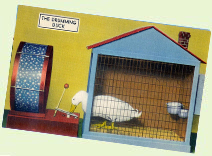 Entertaining, educational, sometimes bizarre – roadside attractions were an American phenomenon motivated in large part by the expansion of the highway system in the 1930s. Along with restaurants and motor courts, attractions cropped up along America’s highways as entrepreneurs brainstormed ways of grabbing the attention of motorists and a few of their tourist dollars. The results were often eye-catching, curiosity inspiring, have to see to believe creations.
Entertaining, educational, sometimes bizarre – roadside attractions were an American phenomenon motivated in large part by the expansion of the highway system in the 1930s. Along with restaurants and motor courts, attractions cropped up along America’s highways as entrepreneurs brainstormed ways of grabbing the attention of motorists and a few of their tourist dollars. The results were often eye-catching, curiosity inspiring, have to see to believe creations.
One of our favorite roadside attractions still operating is the Petrified Creatures Museum in Richfield Springs, New York. It makes for a great detour if you happen to be traveling Route 20 in the summertime. It features a nice park-like setting, huge fluorescent dinosaurs, an ancient sea bed for fossil digging, and a self-service educational tour with vintage sound recordings. Did we mention the fluorescent dinosaurs? Possibly best of all, they have a quirky gift shop packed to the gills with rocks, fossils, pennants, and an astounding variety of dinosaur merchandise. Although we believe the Museum is currently for sale, we hope the new owners will choose to continue the legacy that began back in 1934.
 Another interesting attraction worth a detour is the Peterson Rock Gardens outside of Bend, Oregon. Started by Rasmus Peterson in 1935, the Gardens are filled with miniature castles, churches, bridges, and temples made of local rocks, minerals, petrified wood, and obsidian. You’ll also find some pretty amazing lagoons and a replica of the Statue of Liberty. The gift shop displays a mind boggling variety of colorful rocks and hosts a black light room for fluorescent mineral viewing. You can also bring along a picnic lunch and enjoy the outdoor tables with the peacocks. Although the Gardens are showing some of their age around the edges, it’s still a treat to spend a little time here admiring Mr. Peterson’s creations.
Another interesting attraction worth a detour is the Peterson Rock Gardens outside of Bend, Oregon. Started by Rasmus Peterson in 1935, the Gardens are filled with miniature castles, churches, bridges, and temples made of local rocks, minerals, petrified wood, and obsidian. You’ll also find some pretty amazing lagoons and a replica of the Statue of Liberty. The gift shop displays a mind boggling variety of colorful rocks and hosts a black light room for fluorescent mineral viewing. You can also bring along a picnic lunch and enjoy the outdoor tables with the peacocks. Although the Gardens are showing some of their age around the edges, it’s still a treat to spend a little time here admiring Mr. Peterson’s creations.
Jumping back in time a little, one of the largest communities of roadside attractions in the 1930s – early 1960s could be found along Florida’s highways. Supported by Florida’s combination of mild year-round weather, natural beauty, and smooth roads, mom and pop attractions sprang up by the dozens, each with a unique approach to entertaining tourists.
Three roadside attractions that were wonderful examples of the Florida tourist industry were the amazing Atomic Tunnel, Casper’s Alligator and Ostrich Farm, and Tiki Gardens. Although now long gone, they continue to pique our curiosity.
The Atomic Tunnel, situated on US Route 1 seven miles south of Daytona Beach, operated from 1951 – 1959. An Atomic Tunnel? Nothing less than a Cold War nuclear fallout shelter converted to a combination aviary and aquarium.
 Promoting Happy the Walking Fish, man eating piranhas, and a panorama featuring the quarters of 16th Century monks living in Turkey, the Atomic Tunnel was an absolutely unique destination.
Promoting Happy the Walking Fish, man eating piranhas, and a panorama featuring the quarters of 16th Century monks living in Turkey, the Atomic Tunnel was an absolutely unique destination.
Casper’s Alligator and Ostrich Farm was another roadside wonder found along Florida’s US Route 1. Opened as a commercial attraction in 1946, Casper’s drew tourists in with an amazing display of wildlife: thousands of alligators and crocodiles, flamingos, exotic birds, a giant 22-foot African python, and ostrich cart racing. Perhaps even more important during those hot Florida summers, Casper’s boasted the south’s largest air-conditioned gift shop.
 Coming at the tail end of Florida’s mom and pop attraction boom, Tiki Gardens opened in 1963 as a Polynesian mini-theme park, a “tropical paradise by day…Polynesian fantasy by night”. Operated by Frank and Jo Byers in Indian Rocks Beach, Tiki Gardens ultimately encompassed more than twelve acres. Tourists could browse eight gift shops, view exotic birds and monkeys, eat at Trader Frank’s world famous restaurant, and walk the Polynesian Adventure Trial to view a variety of enormous tiki statues. According to a brochure of the period, guests were invited to “visit a strange and exciting world; the enchanting land of pagan customs.” Gift shops, great food, and giant tikis – definitely our kind of place!
Coming at the tail end of Florida’s mom and pop attraction boom, Tiki Gardens opened in 1963 as a Polynesian mini-theme park, a “tropical paradise by day…Polynesian fantasy by night”. Operated by Frank and Jo Byers in Indian Rocks Beach, Tiki Gardens ultimately encompassed more than twelve acres. Tourists could browse eight gift shops, view exotic birds and monkeys, eat at Trader Frank’s world famous restaurant, and walk the Polynesian Adventure Trial to view a variety of enormous tiki statues. According to a brochure of the period, guests were invited to “visit a strange and exciting world; the enchanting land of pagan customs.” Gift shops, great food, and giant tikis – definitely our kind of place!
Experiencing a fate similar to many mom and pop businesses of the period, roadside attractions were heavily impacted by the passing of the Federal-Aid Highway Act of 1956. This long-range plan called for 40,000 miles of interstate superhighways to be built across the country. In Florida, routes like US 1 that were once main thoroughfares were bypassed by limited access interstates that reduced local highway traffic to a fraction of its previous volume. America’s culture of travel also began to change in the late 1950s with tourists a little less interested in the journey, a little more impatient to reach their destination. As with the history of roadside restaurants and mom and pop motels, the expansion of corporate attractions and shifting land use in the 1960s also took their toll.
America’s culture of travel also began to change in the late 1950s with tourists a little less interested in the journey, a little more impatient to reach their destination. As with the history of roadside restaurants and mom and pop motels, the expansion of corporate attractions and shifting land use in the 1960s also took their toll.
Although the majority of family owned roadside attractions are a thing of the past, they are not forgotten! The Vintage Roadside gift shop offers items featuring authentic graphics from the heyday of roadside attractions, celebrating their history and the adventure of the open road.